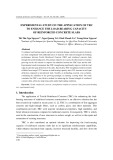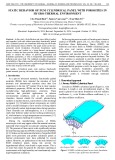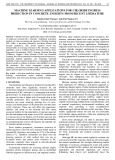
Journal of Science and Technique - Vol. 19, No. 03 (Nov. 2024)
18
STUDY OF INFLUENCE OF COLD ROLLING AND ANNEALING
ON ULTIMATE TENSILE STRENGTH OF AA2024 ALLOY
USING BOX-BEHNKEN EXPERIMENTAL DESIGN
Duc Hoan Tran1, Dang Giang Lai1,*, Van Chinh Nguyen1,
Anh Quang Nguyen1, Van Hoang Nguyen1, Trung Kien Hoang2
1Faculty of Mechanical Engineering, Le Quy Don Technical University
2Institute of Propellants and Explosives, General Department of Defence Industry
Abstract
This study investigates the effects of thermo-mechanical processing parameters, specifically
cold rolling and annealing, on the ultimate tensile strength (UTS) of AA2024 alloy,
employing a Box-Behnken experimental design. The deformation during cold rolling, the
annealing temperature, and the time annealing were varied to evaluate their individual and
combined effects on the UTS. The results demonstrated that the UTS increased with
deformation from 50% to 60%, but decreased with higher annealing temperatures (460°C -
500°C) and extended annealing times (10 to 30 minutes. Among the parameters, annealing
time exhibited the most significant influence on UTS, followed by deformation level and
annealing temperature. The optimized parameters - 60% deformation, 460°C annealing
temperature, and 10 minutes time annealing - predicted a UTS of 628 MPa, with experimental
verification confirming a 3% deviation. This research underscores the critical importance of
controlling thermo-mechanical parameters to optimize the mechanical properties of AA2024
alloy, offering valuable insights for industrial applications.
Keywords: Aluminum alloy 2024; Box-Behnken experimental design; cold rolling.
1. Introduction
Recently, aluminum alloys, with their superior strength, technical properties, and
load-bearing capabilities, have become more widely utilized than pure aluminum.
Aluminum can alloy with elements such as Cu, Mg, Si, Mn, Zn, and Li to form solid
solutions that are sensitive to heat treatment [1, 2]. Among these alloys, AA2024 alloy is
one of the most commonly used across various industries.
AA2024 alloy, commonly referred to as an "aviation material", is highly valued for
its high strength, excellent load-bearing capacity, corrosion resistance, and low specific
gravity. It is widely applied in industries such as aerospace, automotive, electronics, and
the military sector [3, 4]. Due to the unique operational requirements in military
applications, components such as bullet bodies, thermobaric warheads, nozzles, and wind
* Corresponding author, email: danggiang248@lqdtu.edu.vn
DOI: 10.56651/lqdtu.jst.v19.n03.870

Tạp chí Khoa học và Kỹ thuật - ISSN 1859-0209
19
cones, manufactured from AA2024 alloy, require superior mechanical properties
compared to standard parts. To ensure that AA2024 alloy meets these stringent
specifications, it must undergo alloying, heat treatment, deformation, or a combination of
these processes [5].
It has been shown that alloying, heat treatment, and thermo-mechanical processing
significantly influence the mechanical properties of AA2024 alloy. A. Albiter et al. [6-9]
observed that the alloy's maximum strength increased from 379 MPa to 480 MPa when
alloyed with TiC and SiC. Similarly, K. G. Sagar et al. [10] found that the addition of
Beryllium improved the UTS by up to 10.7%. Additionally, F. E. Garchani et al. [11-13]
demonstrated that aging treatments could elevate the UTS of AA2024 alloy to 512 MPa.
The combination of heat treatment and deformation has also been explored as an effective
method to further enhance the strength of AA2024 alloy. Z. Zhu et al. [14] investigated
the effects of continuous extrusion speed, with varying spindle speeds from 4 to 8 rpm,
and heat treatment conditions on the mechanical properties of AA2024 alloy. Their results
showed that elongation reached 12.93% and the tensile strength increased to 497.6 MPa.
R. Luciana et al. successfully determined the superplastic behavior of AA2024 alloy,
particularly under high-temperature conditions of 460°C and appropriate strain rates
(ranging from 8·10−4 to 1.5·10−3 s−1), achieving elongation to failure exceeding 200% and
an average grain size of 5 - 8 μm. The superplastic properties of the AA2024 alloy
samples were developed through a thermo-mechanical processing route, which included
homogenization at 500°C for 8 hours, hot rolling with a 68% thickness reduction followed
by water quenching, cold rolling with a 57% thickness reduction, rapid heating to 480°C
for 15 minutes followed by water quenching, and stabilization annealing at 350°C for
30 minutes [15]. The combination of deformation and heat treatment in thermo-
mechanical processing is widely recognized as an effective approach for enhancing both
the tensile strength and ductility of AA2024 alloy. However, the complexity of these
processing schemes requires precise control over numerous process parameters, making
the evaluation and optimization of these parameters under specific thermo-mechanical
conditions a challenging task.
This study aims to investigate the impact of thermo-mechanical processes on the
strength of AA2024 alloy, with particular emphasis on the effects of key process variables
such as cold deformation, annealing temperature, and annealing time on the alloy’s UTS.
Additionally, the Box-Behnken experimental design [16] has been used in this study to
develop a mathematical model that facilitates a comprehensive assessment of both the
individual and interactive effects of the process factors on UTS. The analysis of the
obtained model provides valuable insights into the influence of cold rolling deformation,

Journal of Science and Technique - Vol. 19, No. 03 (Nov. 2024)
20
annealing temperature, and annealing time on UTS, thereby enhancing the understanding
of how each parameter contributes to the overall strength of the alloy. The model has been
further validated for accuracy through comparison with experimental data under the
predicted optimal conditions.
2. Methodology
2.1. Material
The AA2024 alloy rods, with a diameter of 40 mm, were produced at the X59 plant
of the Z127 factory using the casting-extrusion process. The chemical composition of the
alloy under investigation is shown in Table 1, while the mechanical properties are
provided in Table 2.
Table 1. Chemical composition of experimental AA2024 alloy
AA2024
Chemical composition
Si
Fe
Cu
Mg
Mn
Cr
Zn
Impurities
Al
Sample
0.06
0.10
4.23
1.50
0.49
0.01
0.01
0.02
93.40
Table 2. Mechanical properties of AA2024 alloy before thermo-mechanical process
Alloy
Ultimate tensile strength
(MPa)
Elongation (%)
AA2024
255
5
2.2. Thermo-mechanical processing
The thermo-mechanical processing route described previously in [15] enhances the
superplasticity of AA2024 alloy by promoting the formation of a fine-grained
microstructure. The processes of homogenization at 500°C for 8 hours and hot rolling
with a 68% thickness reduction were implemented to ensure uniform distribution of
alloying elements and reduce grain size. The subsequent stages of cold rolling with a 57%
thickness reduction, rapid heating to 480°C, soaking for 15 minutes, water quenching,
and stabilization annealing at 350°C for 30 minutes increased dislocation density,
strengthening the material and refining the grain structure, thereby improving elongation
and ductility of the AA2024 alloy.
However, to further improve the UTS and ductility of AA2024 alloy, we have
proposed a modified thermo-mechanical processing route based on the approach in [15],
as shown in Fig. 1. In this process, cold rolling was performed with a deformation level
ranging from 50% to 60%, followed by annealing at temperatures ranging from 460°C to
500°C, soaking for 10 to 30 minutes, and water quenching.

Tạp chí Khoa học và Kỹ thuật - ISSN 1859-0209
21
Fig. 1. Schematic diagram of thermo-mechanical processing of AA2024 alloy.
2.3. Experimental design
To investigate the effects of thermo-mechanical process parameters on the UTS of
AA2024 alloy, an experimental design approach was employed. The Box-Behnken
design (BBD) [16], a response surface methodology, was chosen for its efficiency in
optimizing multiple factors while minimizing the number of experiments required.
Table 3. The Box-Behnken design matrix
No.
Exp.
Encoding variable
Real variable
x1
x2
x3
ε, %
T, oC
t, min
1
-
-
0
50
460
20
2
+
-
0
60
460
20
3
-
+
0
50
500
20
4
+
+
0
60
500
20
5
-
0
-
50
480
10
6
+
0
-
60
480
10
7
-
0
+
50
480
30
8
+
0
+
60
480
30
9
0
-
-
55
460
10
10
0
+
-
55
500
10
11
0
-
+
55
460
30
12
0
+
+
55
500
30
13
0
0
0
55
480
20
14
0
0
0
55
480
20
15
0
0
0
55
480
20

Journal of Science and Technique - Vol. 19, No. 03 (Nov. 2024)
22
In this study, three key process variables were selected and coded as follows:
Degree of deformation during cold rolling (coded as x1), ranging from 50% to 60%;
Annealing temperature (coded as x2), ranging from 460°C to 500°C; Annealing time
(coded as x3), ranging from 10 to 30 minutes.
These variables were normalized and coded within the range of [-1, 1]. These
variables were varied systematically according to the Box-Behnken design matrix, which
includes 15 experimental runs. The design matrix, shown in Table 3, outlines the
combination of factor levels for each experiment, ensuring an effective evaluation of the
individual and interactive effects of the variables on the UTS.
The experimental results were analyzed using Modde 5.0 software, with non-
significant coefficients (p-value > 0.05) excluded from the model. Regression analysis
was employed to develop a mathematical model representing the relationship between the
process parameters and the UTS. This model facilitates the optimization of process
parameters to maximize tensile strength.
2.4. Sample preparation
The experimental samples for the thermo-mechanical processing were prepared as
flat plates with dimensions of 4.5 mm in thickness, 15 mm in width, and 60 mm in length.
These samples were cut from a cylindrical aluminum alloy bar with a diameter of 40 mm
using a wire-cutting method. The 15 initial experimental samples, prepared according to
the thermo-mechanical processing route, are presented in Fig. 2a.
Following the proposed thermo-mechanical processing sequence, the samples were
first homogenized at 500°C for 8 hours, followed by water quenching. Subsequently, the
hot rolling process was conducted in a unidirectional manner, achieving a 68% reduction
in thickness, resulting in a 1.44 mm thick strip, which was also water quenched. The
processed samples, as depicted in Fig. 2b, were then utilized for the Box-Behnken
experimental design.
Fig. 2. Initial samples (a) hot rolled samples (b).





















![Bài giảng Công nghệ chế tạo: Chương 4 - Chuẩn [Tối ưu SEO]](https://cdn.tailieu.vn/images/document/thumbnail/2025/20251229/kimphuong1001/135x160/38191766998325.jpg)




